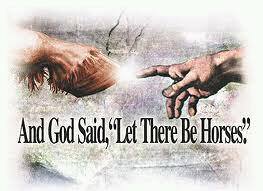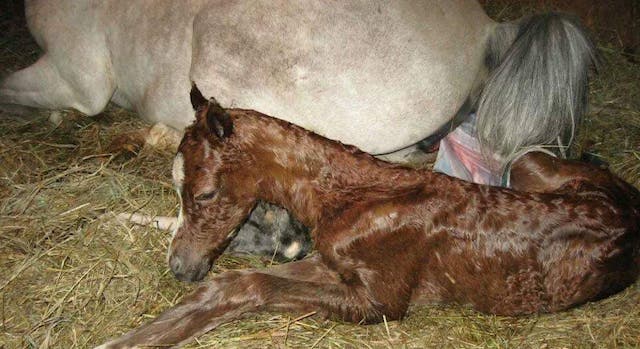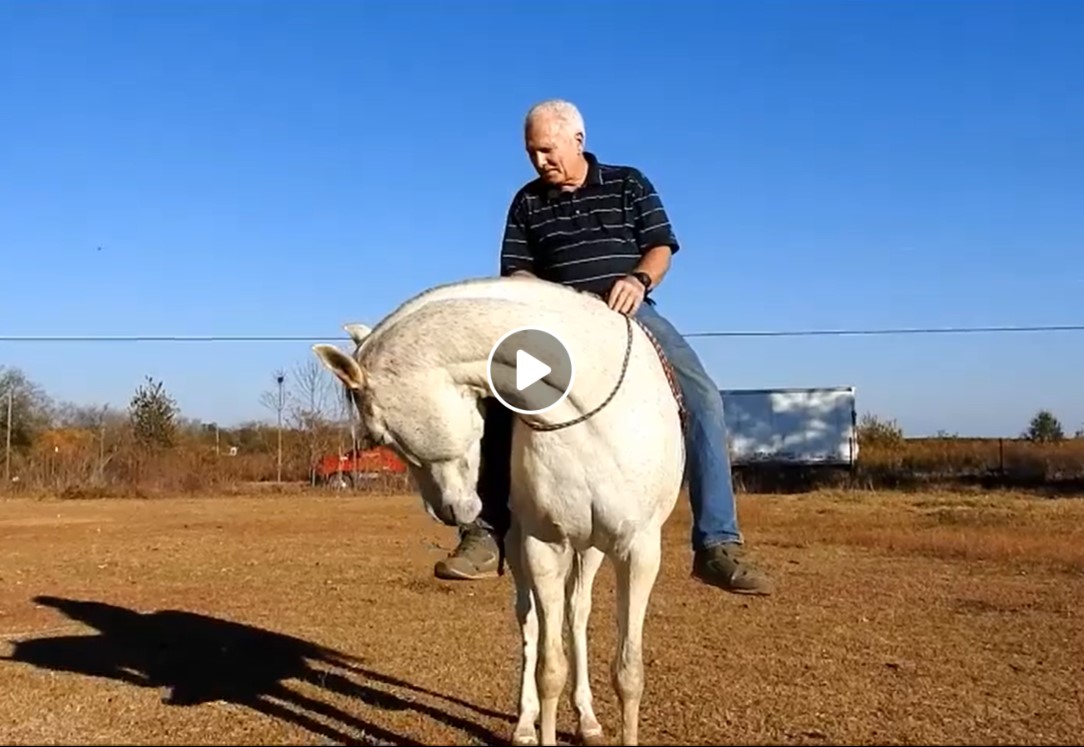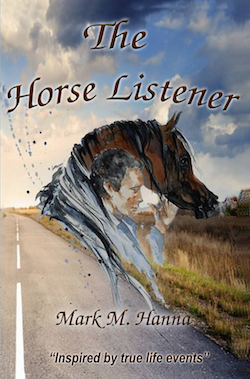Educating foals from the time of conception?
Can we do that?
In my opinion, YES!
The education of a horse begins from the time of conception and starts way before that with the education of the dam and the choosing of the sire. Why do I come up with such crazy things as this?
Well, after years of doing it the wrong way, I have finally accomplished doing what I think is the right way resulting in a well rounded and sensible horse that has the ability to easily live in our world, the world of the human being. A “PREDATOR”. I have a lazy streak inside of me and I don’t like to do things over and over again, in other words, twice. That may seem a tall order for the average horse owner who gets a horse from the local auction like my character Mathew and his mother Marcia with no experience with horses at all from my book “The Horse Listener”. This article is aimed at that beginner. I desire to educate the owner, a youth with supporting parents or a first time older person or even the existing horse owner who does not have this hard earned knowledge.
I have been brought up by Arabian horse breeders who have held the philosophy of choosing temperament and trainability above all other traits that are desirable in their breeding choices. Starting with the sire. The time-honored tradition of the European model in countries like Germany, Spain, Poland and other countries where temperament and trainability are scored highest in the testing of their sires included in their stud books. We can choose our stallion with these desirable traits first without sacrificing the athleticism and conformation we are looking for. But, sometimes the temperament is not chosen first. Winnability takes precedence as their first choice. This has slowly weakened our precious bloodstock from within because that defining characteristic, “winnability” changes all the time. Our first priority should be in maintaining the highest quality to preserve the heritage of strong traits. This so-called improvement sire, where conformation, temperament and trainability.
Likewise, we should choose our dams the same way. The mare is the most influential partner in our breeding barn. In the Bedouin cultures of the Middle East, the mare is prized highly in the pedigrees. In fact, their pedigrees place the mare on top, not the stallions. Why is this? The environmental contributions the mare makes has a stronger influence upon the foal. The mare was chosen for her strength of character as a priority as her dam had been before her and so on. They revere them highly. Not only were they chosen for their bravery and loyalty to their masters in times of war where they would not call out their presence as a stallion may tend to do because of their nature. They also played a role in nurturing the tribe’s children. They were often allowed to abide with them in their tents. The nutritious mare’s milk would supplement their diet along with dates and other precious scarcities for their subsistence in the desert. Ideally then, observe the history of the tail female lines of both sire and dam. Knowing how the mare influences the foal in so many ways, a desirable temperament should be a highly sought after trait that will ultimately be passed on to the foal.
I once was a mare barn manager. When I arrived at the stud, the mare barn was populated by 35 plus pregnant mares whose foals will be exposed to a deadly bacterial disease in the soil that was devastating their foal crop in previous years. To alleviate that disease from their new foal crop, they undertook an aggressive campaign to stop the losses. They would soon after birth, give the foal a serum transfusion from high titre foals to this disease. They also had to take the temperature of the foals every day to watch for elevated temps. I noticed that this would take them at least two and a half days to temp the small numbers of foals that were already born. There were 40 more mares to foal on the horizon needing to be temped. This was unacceptable because along the way there were foals who would be unnoticed in time to treat for the devastating disease. I knew that my experience in educating the many foals I had raised, the process of taking temps could be improved immensely.
I have developed through the years, a process of educating young foals early to give them the foundation they need to be easily worked with and will introduce them into our world. This interaction would help them to see me as their trusted safe haven and not someone, like a predator, to be feared. Their first priority, the nature of the newborn foal is to survive. The foal has been given the gift of that instinct to survive from her dam through her nerve pathways at birth. They can get up early after birth and naturally run and escape from a predator. The lessons that both the mare and I contribute early develop trust. Our knowing the nature of horses and how it relates to our interaction with them will help us teach the foal to survive in our dangerous world. That is the bargain we make with them after taking them out of their world.
I am aware of imprinting and the methods some people use on the newborn foal. I have seen some people be rather forceful in their process of imprinting. They may think that getting used to hard handling will be useful in their task of imprinting. My opinion is the opposite of that which I will explain in this article. It helps to have a mare that is trustful of you to handle her newborn. I would proceed to start with a series of lessons taking into consideration the foals strength and coordination at usually about one week of age. Also in order to not stress them out, I spread out the three lessons, about an hour and a half total.
When I enter the stall, I sit in the corner and ask the mare for permission to enter their world. With that granted, I let the foal notice me. Some foals are evasive and some are curious and will come over to me and check me out. It is helpful if the mare communicates to her foal that I am not a threat. If the mare is distrusting of me, it is transmitted to the foal and it makes your efforts that much harder. There is one event in the new foals interaction with us that will be a shock to them, my first capture and control. A foals instinctual response to danger is passed on in their nerve endings through the mare as mentioned above. It is their nature to be wary of you. Consider their first natural reaction to survive at all times. You can cradle them softly around their butt and chest when gaining control without fighting them. I try to do it with the least amount of stress and I eventually get down on my one knee after I guide them into a corner so as to give the foal a confinement of sorts with two extra walls to aid me. At first, they will try to jump over you, their only route of escape, but done properly you can confine them quietly. As you notice when their heart rate decreases and they get used to the first big shock of your presence so close you can proceed with your first lesson. You will notice their gnawing at you with their mouths in submission. I love it when the mare is there with me touching the foal to let them know all is OK with me being there.
It is important to have a mare who will work with you freely and not haltered or tied. Get this accomplished first to avoid the communication of danger to the foal. I will, with the mares help caress softly many parts of the body and back off if there is an adverse reaction. Approach and retreat if this adverse reaction occurs. Gradually, the foal will not try to escape those touches and will allow you to continue all over the body. All the while, keep the foal in your control quietly, they will try to find that surprise time to escape though. Stay down to their size on your knee, it’s not intimidating. After this first introduction, I will look for a good time to end it on a good note, when you can get up without the foal escaping your grasp. Try to wait until you can get up and walk away without the flight reflex kicking in. If this is done successfully, you will have a foal that will let you get close to them next time without them trying to escape. When and if they fight, back off and go with them softly while maintaining this subtle control. The foal will learn the first and most important lesson you will impart to them, you are not a danger to them. They will unlearn the instinct to escape from you but will trust your touch and go with you.
The nature of a horse is to seek safety from a predator. We are that predator. They are the prey that is usually pursued and eaten by that predator. We as predators chase down and catch them, then hold them down while they try to escape our grasp or fight us until they ultimately submit to you. We are not to act like that predator and should unlearn our instincts to grasp and control and hold on to them tightly when they try to escape. You can accomplish this by softening your grasp when they fight or try to escape but still have subtle control.
For an example, If you pick up a foot of your own horse, they tend to pull away from your grasp. We as a predator will hold on to the foot as they fight to pull it away from you and it becomes a battle. It will set up a bad memory where the foal or the horse will anticipate your grasp and fight because of a learned human-caused problem. If you will relax your grasp, the fight reflex will be decreased because they realize there is no danger inherent because you did not act like a predator and hold on until they submit. After all, you don’t want a horse to learn submission from your wrong handling practices. Submission is contrary to a future partner that is trusting and wanting to learn from you. When you use submission as a tool in training, the only reaction will be opposition to you. They will learn to oppose you to avoid the pain and discomfort. Their only reaction will not be learning but opposition. The lesson here is simple.
You can’t win a battle with a horse by fighting with them because they will fight back in order to survive. You should never use force or become angry. Understand and anticipate when they are reacting like a prey animal. If a horse has learned from a human that they can’t trust you, you have to understand that they are reacting to learned events. Our job is to know when they are anticipating a dangerous action from you. We should never fulfill that anticipated event and understand why they would have reacted to that event. It is a learning process for us, but with experience and understanding their natural instincts to survive, we can let them know that we understand why they are reacting like they are. They learn to trust us if we don’t fulfill their expectations of past pain and discomfort of human-caused problems.
My next lesson I will enter the stall similarly to the first lesson. If you have done a good job to elicit less flight, you will be able to handle the foal and cradle again to the corner to make it easier for you to maintain subtle control. I will touch softly like before all over, but not strongly. I don’t believe in holding down a foal to imprint. Some imprinting methods are teaching submission during this process. This process diminishes the foals future learning process, teaching them to submit rather learn and ask for more learning. I usually get a response where the foal grooms me back. This is very desirable and allows for the foal to relax. You will notice a cocked foot during this wonderful moment. Maybe a little chewing and that soft eye and ears that will give you a friendly flicker. I can back off and the foal will willingly stand without trying to escape and is starting to enjoy my presence. A soft touch like a mare will do to ask for the foals compliance is preferable now. They will not understand at this stage, a harsh disciplinary movement from you because of their instinct to protect themselves. They initially perceive you as a potential predator. It is all they know right now. So remember to be judicious in your handling and understand the fact that they are learning to trust you.
Our next lesson will begin to teach the foal to react to our directives in a safe manner. We as predators have to unlearn our instincts that I described above when teaching this phase. And by the way, we need to learn that lesson permanently when dealing with horses, period, if we want to have a harmonious relationship and partnership with them. We both have to learn from each other when we enter each other’s worlds. But we bear most of the responsibility to teach them because we are supposedly more intelligent and use reason where the horse is instinctual. A foal’s nature is first to survive. If they react like prey animals, the result is very dangerous for the foal who only knows how to flee from you and fight you. A foals natural reaction to danger is to pull back, push against, run over an immovable object, escape from a snake that is attached to the halter (lead rope) which ends up with the foal running through a fence or gate. If they pull back and break a board because you had tied them to it (your mistake) and run from that monster that is chasing them resulting in the same outcome as the snake. Pull back and then jump forward when tied either into you or a solid wall or the manger of your trailer. Now is the time to teach the foal to give way. Teaching the foal to give way is the key to their existence in our world which is fraught with dangers. In the wild, those dangers exist, but our goal is to keep them alive by teaching them to give way. It is a good time to point out that many of the injuries to horses and their owners can be prevented by directing this kind of education to young foals as well as our older horses. But, unfortunately, man-caused disasters occur because of the lack of knowledge of our horse owners. So I am writing this to help the owners develop skills that will result in a more safe environment for horse and man.
Now after all of this GIVE WAY rhetoric, just what is meant by this term? When ever you sense the foal is fighting you, back off. You are too strong and your predator nature is showing its ugly head. The goal is for you to teach the foal to unlearn their instinctive reactions to your restraint by giving way to pressure. How do you accomplish this? Now that you have the more amicable foal in your control by softly cradling on your knee down to their level, groom them like before and then back off a little step back. You will be able to draw the foal towards you on their own. When they make this first step, to me, this is the most emotional experience I have when teaching these foals. It often brings tears to my eyes. They are now wanting to be in your presence. You will see their tails wag softly and the feet and legs will be a little cocked and relaxed. Their desire to escape is no longer there if you have done your job. You can now start to ask the foal to move with your touch while you are cradling them with a soft touch on their butts while gradually increasing the pressure until they make the slightest movement, this should be followed by an instant release of your pressure as a reward. You can ask more at first to help them, but it is an ask and then a response from them that will be a learned response instead of an action because you forced them to move. Never use force, but ask first and then let them follow upon learning.
I hope you don’t think that this is arrogance on my part. It is not. The mistakes I have made with my horses early on was filled with extreme anguish and pain for my horses as well as for me in the process of my learning. I have a lot, I mean a lot of apologizing to my horses when I meet them again up yonder. I could explain my philosophy this way; I would rather guide my first-time horse owner described above and attempt to help them avoid those maladies and foibles.
Stay tuned to Part two. In my next episode, Part two, I will discuss a method to teach a foal to deal with the ever-present restraint that will be present in their lives. This will result in a horse that is tractable and easy to work with, free from the dangers present in our world because we teach them to give way to pressure instead of acting instinctively. I will answer the questions you may have relating to my comment that you can start to train your foals in utero starting at conception.
Please comment below with sharing your Experiences
and any questions you might have.





Mark,
Wonderful information.
Teri, Thanks for your comment. When you utilize these tips to get close to your partner, the horse, you get very close, even spiritually because you have an empathy for them. It has given me great opportunities of growth in my own life and relationships.
“”notice their gnawing at you with their mouths in submission””
Horses are not dogs. The gnawing of the foals is FEAR.
This is a very good informative article about handling the newborns. This is exactly what I do to mine. It seems when you make yourself smaller. They are not near as intimidated. By sitting in the stall patiently and waiting for them to come to you is the ultimate satisfaction and their acceptance as you as one of them and not the predator.